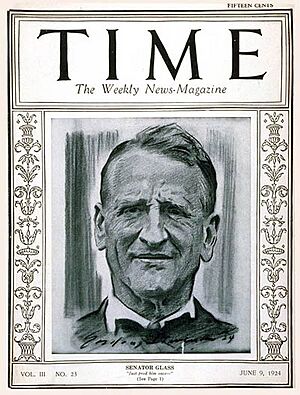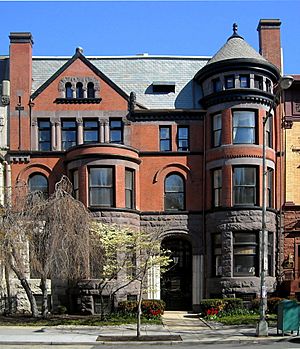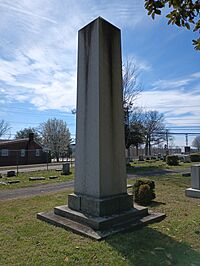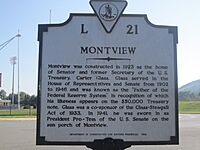Carter Glass facts for kids
Quick facts for kids
Carter Glass
|
|
|---|---|
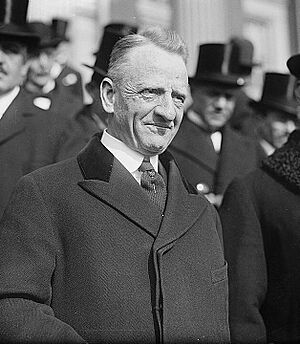 |
|
| President pro tempore of the United States Senate | |
| In office July 11, 1941 – January 3, 1945 |
|
| Preceded by | Pat Harrison |
| Succeeded by | Kenneth McKellar |
| Chair of the Senate Appropriations Committee | |
| In office March 4, 1933 – May 28, 1946 |
|
| Preceded by | Frederick Hale |
| Succeeded by | Kenneth McKellar |
| United States Senator from Virginia |
|
| In office February 2, 1920 – May 28, 1946 |
|
| Preceded by | Thomas S. Martin |
| Succeeded by | Thomas G. Burch |
| 47th United States Secretary of the Treasury | |
| In office December 16, 1918 – February 1, 1920 |
|
| President | Woodrow Wilson |
| Preceded by | William McAdoo |
| Succeeded by | David F. Houston |
| Chair of the House Banking Committee | |
| In office March 4, 1913 – December 16, 1918 |
|
| Preceded by | Arsène Pujo |
| Succeeded by | Michael Francis Phelan |
| Member of the U.S. House of Representatives from Virginia's 6th district |
|
| In office November 4, 1902 – December 16, 1918 |
|
| Preceded by | Peter J. Otey |
| Succeeded by | James P. Woods |
| Member of the Virginia Senate from the 20th district |
|
| In office December 6, 1899 – November 4, 1902 |
|
| Preceded by | Adam Clement |
| Succeeded by | Don P. Halsey |
| Personal details | |
| Born | January 4, 1858 Lynchburg, Virginia, U.S. |
| Died | May 28, 1946 (aged 88) Washington, D.C., U.S. |
| Political party | Democratic |
| Signature | |
Carter Glass (born January 4, 1858 – died May 28, 1946) was an American newspaper publisher and Democratic politician. He was from Lynchburg, Virginia. He served in both the House and Senate. He also worked as the United States Secretary of the Treasury for President Woodrow Wilson.
Glass was very important in creating rules for banks and money in the U.S. He helped set up the Federal Reserve System, which is like America's central bank. He also helped create the Federal Deposit Insurance Corporation (FDIC), which protects money you put in a bank.
After working with newspapers, Glass became a state senator in Virginia in 1899. He later became a U.S. Representative in 1902. As chairman of a banking committee, he worked with President Wilson to pass the Federal Reserve Act. This law created the central banking system for the United States.
Glass was Secretary of the Treasury from 1918 to 1920. Then, he became a U.S. Senator for Virginia. He served in the Senate from 1920 until he died in 1946. He became a leader in the Senate, serving as president pro tempore from 1941 to 1945. He also helped pass the 1933 Banking Act, known as the Glass–Steagall Act. This law created the FDIC and separated different types of banks.
Glass believed that states should have more power than the national government. He disagreed with many of President Franklin D. Roosevelt's "New Deal" programs.
Contents
Early Life and Education
Carter Glass was born in Lynchburg, Virginia, on January 4, 1858. He was the last child of Robert Henry Glass and Augusta Elizabeth Christian. His mother passed away when he was only two years old. His older sister, Nannie, helped raise him.
His father, Robert Henry Glass, owned the Lynchburg Daily Republican newspaper. Carter started working as an apprentice printer for his father when he was 13. He loved to read and taught himself a lot by reading books by famous thinkers like Plato and William Shakespeare.
Starting a Career
When he was 19, Glass moved to Petersburg, Virginia. He wanted to be a newspaper reporter but couldn't find a job there. So, he returned to Lynchburg. He worked as a clerk for a railroad company for a few years.
At age 22, Glass finally became a reporter for the Lynchburg News. He worked hard and became the newspaper's editor by 1887. The next year, he bought the newspaper. He wrote strong articles and made the paper better, which helped sales grow. Soon, he bought other local newspapers, becoming the main newspaper publisher in Lynchburg.
Entering Politics
As a respected newspaper editor, Glass often wrote about politics. He was elected to the Senate of Virginia in 1899. He also helped write Virginia's new constitution in 1901–1902. This new constitution created the State Corporation Commission to regulate railroads and other businesses.
Glass was a strong supporter of policies that made it harder for African Americans to vote. The new constitution required people to pay a special tax and pass a reading test to vote. Glass openly said these rules were meant to reduce the number of African American voters. After these rules were put in place, the number of African Americans who could vote dropped a lot.
Serving in Congress and as Treasury Secretary
Glass was elected to the United States House of Representatives in 1902. In 1913, he became the chairman of the House Committee on Banking and Currency. He worked with President Woodrow Wilson to pass the Glass-Owen Federal Reserve Act. This important law created the Federal Reserve System, which manages the nation's money supply and oversees banks.
In 1918, President Wilson chose Glass to be the United States Secretary of the Treasury. His signature appeared on money printed during his time in office. He served as Treasury Secretary until 1920.
After leaving the Treasury, Glass was appointed to the United States Senate in 1920. He served in the Senate for the rest of his life. He became chairman of the Appropriations Committee in 1933. From 1941 to 1945, he was the President pro tempore, a high-ranking position in the Senate.
One of his biggest achievements as a Senator was helping to pass the Glass–Steagall Act. This law separated regular banks from banks that deal with investments. It also created the Federal Deposit Insurance Corporation (FDIC), which protects your money if a bank fails. Even though he helped pass it, Glass was not happy about the idea of bank deposit insurance at first.
Glass was a strong supporter of states' rights, meaning he believed states should have more power. He often disagreed with President Franklin D. Roosevelt's New Deal programs.
Later Life and Legacy
Carter Glass was married twice and had four children with his first wife, Aurelia McDearmon Caldwell. She passed away in 1937. He remarried in 1940 to Mary Scott.
Towards the end of his life, Glass became very ill and could not attend Senate meetings after 1942. However, he refused to resign from his position. He passed away in Washington, D.C., on May 28, 1946, at the age of 88. He is buried in Spring Hill Cemetery in Lynchburg, Virginia.
Glass's home, "Montview," is now a museum on the grounds of Liberty University in Lynchburg. A bridge in Virginia, the Carter Glass Memorial Bridge, is named in his honor.
In 1936, Carter Glass was featured on a special U.S. coin, the Lynchburg Sesquicentennial half dollar. This was rare because he was still alive at the time. Only a small number of these coins were made.
A building at Harvard Business School was named after Glass in the 1920s. However, in 2020, the name was removed. This was because of Glass's efforts to make it harder for Black citizens to vote through things like poll taxes and reading tests. The building was renamed Cash House.
Images for kids
See also
- List of United States Congress members who died in office (1900–49)
Works


